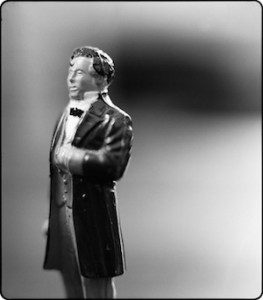
Three quarters of the way through Alex Forman’s multimedia paean to presidential minutiae, Tall, Slim & Erect: Portraits of the Presidents, you hit this candid entry from Harry Truman’s 1947 diary:
This great white jail is a hell of a place in which to be alone. The floors pop and crack all night long. Anyone with imagination can see old Jim Buchanan walking up and down worrying about conditions not of his making. Then there’s Van Buren who inherited a terrible mess from his predecessor, as did poor old James Madison. Of course Andrew Johnson was the worst mistreated of any of them. So the tortured souls who were and are misrepresented in history are the ones who come back.”
No doubt Truman’s thinking here springs partially from self-preservation. After all, this entry comes just seventeen months after he personally okayed the instantaneous obliteration of two large Japanese cities. It’s only natural his thoughts might tend toward hauntings, the intense weight of elected office, and a portrait of the president as a man subject to terrible “conditions not of his making.”
But there’s also genuine sympathy in Truman’s imagined purgatory of ghosts here. The loneliness he voices is the loneliness of a public figure who realizes he doesn’t belong to himself anymore, a man who can almost feel himself turning into a full-fledged subject of history. Like Buchanan, Madison, and Johnson before him, Truman knows he’ll one day become the sum total of all those misremembered, partial, and editorialized stories people will tell about him when he’s not around. American history—that silo where so much national desire gets housed—will become the space that both animates and imprisons him. Faced with a tricky narrative terrain like that, it’s hard to blame him for being concerned about how he might look.

Like Truman, Alex Forman is deeply interested in the way American presidents get represented and what those representations might mean. Riffing on a format that will no doubt look familiar to anyone who remembers the slim presidential biographies that dot public school libraries, Tall, Slim & Erect combines the visual and the literary, reducing each of the first thirty-seven presidents to a portrait and a one-page bio. The net result isn’t an intentional act of misrepresentation (Truman’s ghost can breathe easy), but rather a playful, oftentimes eerie, act of multiple-representation, an exploration of the presidents as spectral men living somewhere between historical fact and the disparate narratives of national myth.
Let’s start with the portraits. Forman’s photographs are of miniature presidential figurines (a collection designed by the Louis Marx Toy Company, popular in the mid-twentieth century) that she chanced across at a flea market. Shot in extreme close-up, the three-inch tall plastic molds swell and dominate the frame, which grotesquely highlights the creases in foreheads, the positioning of hands, and the subtle shock locked away in many of the figurines’ eyes. The cumulative effect is unsettling and mesmerizing. Forman encodes full-on narratives in each one of these portraits, and believe it or not, a lot can be gained from staring at the puffer-fish swollenness of Pierce’s face (a side-effect of his alcoholism?) or the shadowy cleft that scores LBJ’s chin like a machete wound. Why, we ask, is Harding peeking at us from around a corner? What’s keeping John Tyler from looking us directly in the eye? And why might Lincoln have his back turned, walking away, as if he were trying to vanish into the binding of the book?
These photographic narratives play off and inform the short biographies that follow them, textual mash-ups Forman has cribbed from letters, novels, history books, and websites. These anecdotes focus primarily on the corporeal and arcane, chronicling a wide, and often funny, variety of presidential curiosities. John Quincy Adams was flatulent and liked skinny-dipping in the Potomac. FDR was anorexic, Madison arthritic. George Washington may have been impotent. Some of Forman’s other finds tread seedier ground: affairs (FDR and Kennedy), possible secret histories of homosexuality (Buchanan, Arthur, Lincoln), and even hints of incest (Rutherford B. Hayes).
Forman emphasizes her role as a curator, not a creator, of these biographies, openly admitting in her bibliographic headnote that “none of the text herein was written by me.” But while calling Tall, Slim & Erect an “unwritten” book might accurately describe its reliance on found materials, it drastically downplays the particular intelligence of Forman’s selective methods. Every sentence here has existed before, but never in this particular way. It’s Forman’s appropriative threading—intentional and meticulous—that illuminates and renews the language.
Nowhere is this clearer than in Forman’s knack for honing in on and juxtaposing the drastic tonal shifts that mark the wide-ranging territory of presidential biography. Some sentences here are purely descriptive (“Taft was 5 feet 11 ½ inches tall.”). Others are interpretive or veer toward the critical (“Lacking drive or decision in civilian life, [Grant] was a failure in everything he did.”). And some teeter into the outright lionization you might expect more readily from a fan contributing his two cents to Bob Seger’s Wikipedia page (“Theodore Roosevelt was an artist of power.”).

This mix, of course, closely approximates the way history actually works for most of us, where the presidents exist as little more than the trivia we haphazardly collect about them, but these drastic shifts also remind us of the way that the presidency often serves as one of the focal points of America’s mythic projection of itself, a conduit of both national anxiety and desire. In Madison’s biography, for example, the clinical appraisal of his height and weight (at 5’4” and 100 pounds, he was the tiniest president) is followed, almost in the same breath, with this account: “This withered little apple-John was the father of the Constitution.” It’s the way Forman collides empirical realism with the perfectly struck chord of folksy grandeur that’s especially revealing here: the montage hints at something hard-edged, then veers sharply toward the populist and democratic. It embodies a principle Americans want desperately to believe about themselves, as if the mind behind the Constitution was just another version of Rudy, undersized but plucky, able to make the football team through sheer will.
This montage method of composition gives Forman’s biographies their strange, compelling type of noise, and it elegantly allows her to accomplish two things at once. On the one hand, the historical nuggets on presidential bodies work to humanize figures who are too often portrayed—on our money, in the portraits lining our classrooms, by Tea Party purists who believe Jefferson’s quill was divinely inspired and infallible—as pure things of myth. To be reminded that these men were corporeal de-elevates the tempting notion of American exceptionalism, offering a healthy reminder that the supposed great men who led the supposed-greatest country in history also got the hiccups.
But just as these bodily anecdotes lull us into thinking that the presidents aren’t all that different from you or me, Forman injects her biographies with daunting historical realities that compel us to remember, frighteningly, that they are. When we read, for example, that Truman “was briefed about the atomic bomb for only thirty minutes, after he had become president,” or that Jackson’s signing of the Indian Removal Act displaced over 45,000 American Indians, the effect can be chilling. Moments like these hit like lightning flashes, and they’re an awful reminder of the earth-shifting power we actually put in the hands of a human beings who shit, fart, and get toothaches.
Ultimately, I don’t think Forman is suggesting that the presidents are empty figures, vacancies created solely by the narratives we tell about them. Her close corporeal focus persistently reminds us that there is a “there” there in this case. But Tall, Slim & Erect is interested in interrogating the nature of historical coherence. Even as the language works formally to give the semblance of “unified” portraits, the wide-ranging accounts are centrifugal in force. The sentences, both in what they say and how they say it, strain at one another, catapulting the presidents through the prism of history, leaving only fragments and hazy lines of demarcation. Even as we turn the pages and see them pinned like insects in microscopic close up, the feeling we’re left with is one of whether or not we’ll ever be able to see these men, or anything for that matter, with the clarity we’d hoped for.




